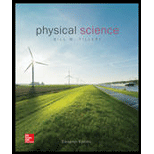
Physical Science
11th Edition
ISBN: 9780077862626
Author: Bill Tillery, Stephanie J. Slater, Timothy F. Slater
Publisher: McGraw-Hill Education
expand_more
expand_more
format_list_bulleted
Textbook Question
Chapter 15, Problem 21AC
Remnants of comets and asteroids found in space are called
a. meteoroids.
b. meteors.
c. meteorites.
d. minor planets.
Expert Solution & Answer
Want to see the full answer?
Check out a sample textbook solution
Students have asked these similar questions
18. From where do comets originate?A. Just outside the orbit of JupiterB. A belt between Jupiter and MarsC. between the orbits of Saturn and UranusD. From the surrounding outer regions of the solar system
Explain Comets?
A meteor with a lengthy history is what?
Chapter 15 Solutions
Physical Science
Ch. 15 -
1. The mass of the Sun is how much larger than...Ch. 15 -
2. The distance from Earth to the Sun is called a...Ch. 15 -
3. What type of planets are Mercury, Venus,...Ch. 15 -
4. Which of the following is most likely found on...Ch. 15 -
5. What is the outermost...Ch. 15 -
6. The planet that was named after the mythical...Ch. 15 -
7. A day on which planet is longer than a year on...Ch. 15 -
8. The day on which planet is about the same time...Ch. 15 -
9. Mars has distinct surface feature-related...Ch. 15 -
10. How many moons orbit...
Ch. 15 -
11. What is the largest planet in our solar...Ch. 15 -
12. Callisto, Europa, Ganymede, and Io...Ch. 15 -
13. The density of Jupiter is
a. 50 percent...Ch. 15 -
14. The only moon in the solar system with a...Ch. 15 -
15. Saturn’s rings are thought to be
a. composed...Ch. 15 -
16. The planet with the lowest average density,...Ch. 15 -
17. The planet that is not a giant...Ch. 15 -
18. What planets are considered...Ch. 15 -
19. Area of the solar system where long-period...Ch. 15 -
20. Short-period comets have orbital periods...Ch. 15 -
21. Remnants of comets and asteroids found in...Ch. 15 -
22. Meteorites are classified into all of the...Ch. 15 -
23. The most widely accepted theory on the origin...Ch. 15 -
24. The belt of asteroids between Mars and...Ch. 15 -
25. Which of the following planets would be...Ch. 15 -
26. Which of the following planets probably still...Ch. 15 -
27. Venus appears the brightest when it is in...Ch. 15 -
28. The small body with a composition and...Ch. 15 -
29. A small body from space that falls on the...Ch. 15 -
30. Planets in our solar system are classified...Ch. 15 -
31. What separates the terrestrial planets from...Ch. 15 -
32. The planet that has the shortest “year” among...Ch. 15 -
33. What planet is called the morning star and...Ch. 15 -
34. Venus “shines” because it is
a. composed of...Ch. 15 -
35. On Venus, the sun rises in the west. This is...Ch. 15 -
36. The “sister” planet to Earth...Ch. 15 -
37. What feature on Mars was considered by some...Ch. 15 -
38. Jupiter radiates twice as much energy as it...Ch. 15 -
39. The Great Red Spot is thought to be
a. a...Ch. 15 -
40. The metallic hydrogen that surrounds the core...Ch. 15 -
41. A shooting star is a...Ch. 15 -
1. Describe the protoplanet nebular model of the...Ch. 15 -
2. What are the basic differences between the...Ch. 15 -
3. Describe the surface and atmospheric...Ch. 15 -
4. What evidence exists that Mars at one time had...Ch. 15 -
5. Describe the internal structure of Jupiter and...Ch. 15 -
6. What are the rings of Saturn?
Ch. 15 -
7. Describe some of the unusual features found on...Ch. 15 -
8. What are the similarities and the differences...Ch. 15 -
9. Give one idea about why the Great Red Spot...Ch. 15 -
10. What is so unusual about the motions and...Ch. 15 -
11. What evidence exists today that the number of...Ch. 15 -
12. Using the properties of the planets other...Ch. 15 -
13. What are “shooting stars”? Where do they come...Ch. 15 -
14. What is an asteroid? What evidence indicates...Ch. 15 -
15. Where do comets come from? Why are...Ch. 15 -
16. What is a meteor? What is the most likely...Ch. 15 -
17. What is a meteorite? What is the most likely...Ch. 15 -
18. Technically speaking, what is wrong with...Ch. 15 -
19. What are the primary differences between the...Ch. 15 -
1. What are the significant similarities and...Ch. 15 - Prob. 2FFACh. 15 -
3. Evaluate the statement that Venus is Earth's...Ch. 15 -
4. Describe the possibility and probability of...Ch. 15 -
5. Provide arguments that Pluto should be...Ch. 15 -
6. Explain why is it difficult to count the...Ch. 15 - Prob. 1IICh. 15 -
1. Based on the density and diameter in km...Ch. 15 - Prob. 2PEBCh. 15 -
3. A scale model of the solar system is being...Ch. 15 -
4. How many times has Uranus rotated on its axis...Ch. 15 -
5. An elementary school class is building a scale...Ch. 15 -
6. A class is building scale models of the...Ch. 15 - Prob. 7PEBCh. 15 -
8. A 1 cm thick piece of lead with a surface area...Ch. 15 -
9. Assume an astronaut at a space station on Mars...Ch. 15 -
10. What is the mass of the Sun, in kilograms,...Ch. 15 -
11. What is the mass of the Sun, in kilograms,...Ch. 15 -
12. Based on Kepler’s third law, what is the...Ch. 15 -
13. Based on Kepler’s third law, what is the...Ch. 15 - Prob. 14PEBCh. 15 -
15. Assuming a circular orbit, what is the...
Knowledge Booster
Learn more about
Need a deep-dive on the concept behind this application? Look no further. Learn more about this topic, physics and related others by exploring similar questions and additional content below.Similar questions
- What is the orbital period of a comet nucleus in the Oort cloud? What is its orbital velocity? (Hints. Use Kepler’s third law in Chapter 4, section 3. The circumference of a circular orbit is 2r . Refer to the text for typical Oort cloud object distances from the Sun.)arrow_forwardIn the future, astronomers discover a solid moon around a planet orbiting one of the nearest stars. This moon has a diameter of 1948 km and a mass of 1.61022 kg. What is its density?arrow_forwardWhat evidence indicates that some asteroids have differentiated?arrow_forward
- Estimate the mass of the object that formed Meteor Crater in Arizona.arrow_forwardHow can Jupiter have a liquid interior and not have a definite liquid surface?arrow_forwardThe mass of an average comet’s nucleus is about 1014 kg. If the Oort cloud contains 21012 comet nuclei, what is the mass of the cloud in Earth masses? Compare that with Jupiter’s mass. (Note: Relevant data can be found in Appendix Table A-10.)arrow_forward
- Which of the following is (are) true of meteoroids? (17.6) (a) They are small, solid, interplanetary metallic and stony objects. (b) They are usually smaller than a kilometer. (c) They are known as meteors when they enter the Earths atmosphere. (d) They are known as meteorites when they strike the Earths surface. (e) All the preceding are true.arrow_forwardA comet has a period of 76.3 years and moves in an elliptical orbit in which its perihelion (Closest approach to the Sun) is 0.610 AU. Find (a) the semimajor axis of the comet and (b) an estimate of the comets maximum distance from the Sun, both in astronomical units.arrow_forwardQ4. (i) Sketch the following positions of the Moon and the Earth.a) New Moonb) First Quarterlyc) Waxing Gibeond) Third Quarter(ii) Write about the following:a) A cometb) A Meteorarrow_forward
arrow_back_ios
arrow_forward_ios
Recommended textbooks for you
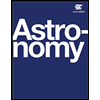 AstronomyPhysicsISBN:9781938168284Author:Andrew Fraknoi; David Morrison; Sidney C. WolffPublisher:OpenStax
AstronomyPhysicsISBN:9781938168284Author:Andrew Fraknoi; David Morrison; Sidney C. WolffPublisher:OpenStax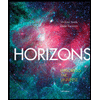 Horizons: Exploring the Universe (MindTap Course ...PhysicsISBN:9781305960961Author:Michael A. Seeds, Dana BackmanPublisher:Cengage Learning
Horizons: Exploring the Universe (MindTap Course ...PhysicsISBN:9781305960961Author:Michael A. Seeds, Dana BackmanPublisher:Cengage Learning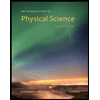 An Introduction to Physical SciencePhysicsISBN:9781305079137Author:James Shipman, Jerry D. Wilson, Charles A. Higgins, Omar TorresPublisher:Cengage Learning
An Introduction to Physical SciencePhysicsISBN:9781305079137Author:James Shipman, Jerry D. Wilson, Charles A. Higgins, Omar TorresPublisher:Cengage Learning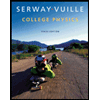 College PhysicsPhysicsISBN:9781285737027Author:Raymond A. Serway, Chris VuillePublisher:Cengage Learning
College PhysicsPhysicsISBN:9781285737027Author:Raymond A. Serway, Chris VuillePublisher:Cengage Learning

Astronomy
Physics
ISBN:9781938168284
Author:Andrew Fraknoi; David Morrison; Sidney C. Wolff
Publisher:OpenStax

Horizons: Exploring the Universe (MindTap Course ...
Physics
ISBN:9781305960961
Author:Michael A. Seeds, Dana Backman
Publisher:Cengage Learning

An Introduction to Physical Science
Physics
ISBN:9781305079137
Author:James Shipman, Jerry D. Wilson, Charles A. Higgins, Omar Torres
Publisher:Cengage Learning

College Physics
Physics
ISBN:9781285737027
Author:Raymond A. Serway, Chris Vuille
Publisher:Cengage Learning
Kepler's Three Laws Explained; Author: PhysicsHigh;https://www.youtube.com/watch?v=kyR6EO_RMKE;License: Standard YouTube License, CC-BY